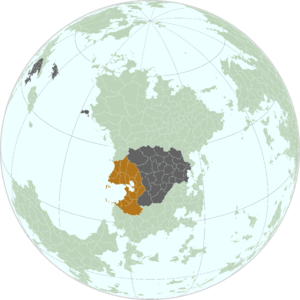Grünland
| Commonhold of Grünland Gemeinschaft Grünland | |
| Flag | Coat of arms |
|---|---|

|

|
| Motto: | |
| Anthem: | |
| Locator map | |

| |
| Capital city | Reisenburg |
| Largest city | |
| Official language | Stoldish |
| Other languages | |
| Ethnic group | Dolmer - Keshkwit - Others |
| Religion | Stellist Orkanan, Irreligion, Others |
| Demonym(s) | Grunlandish, Grunlander |
| Government | |
| Government Type | Orderist technocratic federal subject |
| Oberhauptführer | |
| Your 2nd leader title (e.g. Prime minister) | name |
| Legislature | Upper house - Gründerrat Lower house - Volksforum |
| Establishment | |
| event 1 | date 1 |
| Area | |
| Population | |
| Economy | |
| Economy type | Orderist planned economy |
| Currency | Commonwealth Energy Certificate (GEA) () |
| Other information | |
| Driving side | right |
| Internet code | .soc |
Grünland, officially the Commonhold of Grünland (Stoldish: Gemeinschaft Grünland), is a country in Altaia.
History
Pre-Colonization
Stoldavian Colonization
Colonization in the areas around the Grün Sea region was started in the years immediately after the Greater Stoldavic Empire discovered and established the Stoldavic colony of New Stoldavia on the northwestern shores of Altaia in 7099rh. In general, colonization efforts of the Stoldavic Empire were sponsored and funded by the Greater Stoldavic Empire and its monarch, all in an effort for the monarch to remain in control of the newly found lands. As word spread of the successful colony on Altaia spread, other nations started to prepare for their own colonization efforts, and as a result, the Greater Stoldavic Empire sent a colonization fleet headed by Admiral Hademar Varen to the lands south of New Stoldavia. Coming upon the waters of the Grün Sea in 7111rh, ships split from the convoy to set up small forts and settlements in regions that were protected by a bay or harbor and that had access to a freshwater supply. The initial settlements of the region started out in what is now known as the Maritime States and moved inward towards the Grün Bay to what is now known as the Bay States. After mapping the majority of south-western Altaia and setting up small settlements along the outer Grün Sea region, Hademar’s fleet finally anchored in the relatively protected sea of the Grün Bay. Here Hademar set up the imperial colony of New Grönmark and its capital, New Hapsburg (which would later be renamed New Hapsburgstadt after the entire colony was renamed to New Hapsburg).
Contrasting with the wide mix of Stoldavic ethnic and cultural groups that settled in New Stoldavia, the new colony of New Grönmark was fairly homogenous, with the majority of its settlers coming from the lands of Helland, and in particular, from the states of Thronreich and Stetzen. The wealthy of Thronreich took particular interest in the fertile lands and climate of the lands along the coasts of Grün Bay after the discovery of the tobacco by Hanns Baumgärtner. Wealthy nobles of Thronreich, with the help of merchant giants such as Rudolf Erlichmann, invested heavily in developing the region and setting up plantations all across the bay.
In its efforts to keep up with demand of tobacco and the demand of the ever increasing influx of Stoldavic settlers, the borders of New Grönmark were constantly spreading and clashing with the native Altaians. Using the wealth gained by the colonies, the nobility of New Grönmark hired private security forces to strong-arm the natives off the land.
In the lands that make up the Maritime States, population growth was less from the opportunity to see financial success and was more caused from the spread of Mellanhand Orkanan and to create “utopian communities” through strict following of the Scriptures. Seeking to create a Mellanhand stift on Altaia, Herr Karl Glockner of Stetzen was granted a colonial charter by Emperor Erik II which granted Karl Glockner the rights to colonize along the northern coast of the Grün Sea and the rights to create a new Mellanhand stift that held loyalties to the Emperor himself. The Maritime States would continue to be a popular destination for religious settlers from Stetzen along with Mörenburg for the next five decades, all gathering into Orkanan-based communities. Communal farming and stim-ran fishing companies dominated the economy of the Maritime States in the opening six to eight decades.
In the Maritime States, native Keshkwit Altaians were often left alone as they moved inland away from the coastal, Orkanan communities. This did not last as more and more Stoldavians moved into the region, the demand for land increased, incentivizing Orkanan communities to take additional lands from the Keshkwits. Many Keshkwit tribes were offered three choices, assimilate into the Orkanan communities and society, to sell their land, or die. Most chose to assimilate or to sell their land as word spread of the Altaian massacres of the Bay States.
Under the Stellist Stoldavic Empire
With the splitting of the Greater Stoldavic Empire in 7151rh, the colony of New Grönmark remained loyal to Helland, even at the dismay of the Mellanhand-Orkanan Maritime States. The Bay States remained loyal to Helland for both economic and cultural reasons and opposed all efforts of the Maritime States to oppose the Stellist government in Hoffnung and New Hapsburgstadt. Within three years, strong secession movements could be found throughout the Maritime States, often with local militia groups rallying up to attack tax collectors, court officials from the Stellist authority. When Stellist appointed judges and government officials moved into the Maritime States to uphold the Stellist Stoldavic Empire's laws, they were often ridiculed, ignored, and even attacked.
By the year 7221rh, the Maritime States were in open revolt as the Stellist Kaiser continuously tried to use force to implement obedience in the region. Maritime States declared independence in 7222rh, forming the Orkanan Federated States, an independent government that would stand for the next 14 years before infighting between political factions left the new government vulnerable to Stellist intervention.
In the year 7235rh, Stellist forces moved in to reclaim the Maritime States, through military force and a new policy of religious tolerance towards the Mellanhand Orkanists. Although fighting died down as Stellist forces interfered less on the local government level, fighting was still common if a village experienced "Stellist oppression" in the ways of taxation and duties. As result, the Maritime States had some of the lowest tax rates within the colony of New Grönmark, but one of the highest tariff rates within the colony. The Maritime States are still known to have a relatively large black market and smuggling operations, all dating back to the policies set on the Maritime States.
Under the New Stoldavic Empire
With the marriage between Kaiser Eugen Varen and Kaiserin Elfriede Möre in 7281RH, policies were put into place by the Kaiserin that changed the entire empire's stance on religion. Because Kaiserin Elfriede Möre was a devout follower of Mellanhand Orkanan and a great protector of all branches of Orkanan, policies were implemented to be carried out throughout the entire empire, both of that of the former Stellist Stoldavic Empire and the former Möre Stoldavic Empire, that were tolerant to any Orkanan sect and removed former Stellist-based laws in the Maritime States. With the marriage, the Maritime States saw the Kaiserin's personal favor towards them, to the point where most identified the Maritime States as being part of the "northern" part of the empire (a colony of Mörenburg).
Häverist Commonhold of New Hapsburg
Wolgos Scourge
- Main article: Wolgos Scourge
Recent History
Geography
The Commonhold of Grünland lies on the Grün Bay where most of the Commonhold's coastline lay. Because of this a large part of its coastal territory lay on the seacoast with level and often sandy or marshy ground and arable land is found further inland in the region. The Grünland region is separated from the other Altaian commonholds by the Elfas Hills, a hilly region of eroded mountains, which opens up the vast open plains of Altaia.
Climate
The majority of New Hapsburg is primarily a humid subtropical climate. Long, hot, and humid summers are typical, except at the highest elevations. The subtropical climate made winters mild but allowed infectious diseases to flourish. The entire Commonhold, including the western Altaian mountains, receives moderate to heavy precipitation, which varies from 140 cm in the coastal regions of Grün Bay, to approximately 100 cm around the northeast part of the Commonhold. The degree to which the weather of a certain region of New Hapsburg is subtropical depends on the latitude, its proximity to the Stoldavic Ocean and the elevation.